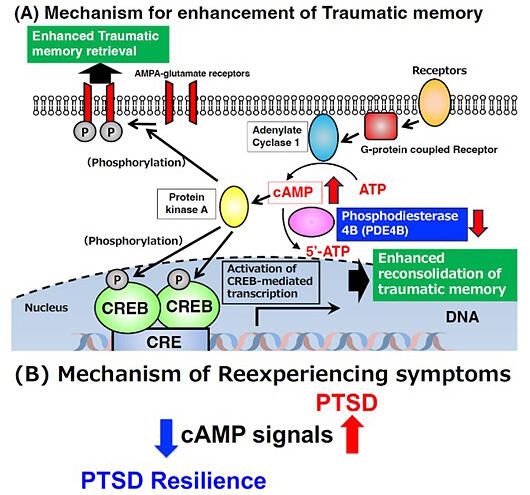A research group led by Professor Satoshi Kida of the Graduate School of Agricultural and Life Sciences at the University of Tokyo, and Director Yoshiharu Kim and Section Chief Hiroaki Hori of the National Institute of Mental Health at the National Center of Neurology and Psychiatry announced that they have clarified the molecular mechanism of post-traumatic stress disorder (PTSD). They comprehensively compared gene expression levels between the peripheral blood of patients with PTSD and the hippocampus of PTSD model mice. In both patients and mice, phosphodiesterase 4B (PDE4B), a negative regulator of the cAMP signaling pathway, was found to be expressed at reduced levels. They also confirmed that the expression level was lower in patients exhibiting more severe re-experiencing symptoms and that activation of the cAMP signaling pathway re-consolidated traumatic memory in a mouse model. The results are expected to lead to the development of diagnostic and therapeutic methods for PTSD. The results were published in the February 27 issue of the international academic journal Molecular Psychiatry.

(A) Molecular mechanism of trauma memory retrieval based on previous research performed by this group (Hasegawa et al., Nat Commun., 2019) and the findings in this study.
(B) Onset of PTSD re-experiencing symptoms by overactivation of the cAMP signaling pathway
Provided by the University of Tokyo
PTSD is a psychiatric disorder that can develop after a traumatic experience, leading individuals to become aware of death. Its main symptoms include re-experiencing symptoms (such as flashbacks, where traumatic memories resurface), avoidance and hyperarousal. Among these, re-experiencing symptoms are recognized as unique to PTSD. In recent years, research has focused on applying findings from fear memory studies, particularly in rodents, to PTSD treatment. This takes advantage of the fact that fear memory, a typical example of traumatic experiences, is universal across different animals. However, there is no therapeutic drug because the mechanism of pathogenesis remains unknown, and only drugs that alleviate symptoms are prescribed.
To clarify the molecular mechanisms of PTSD, the research group comprehensively compared mRNA expression levels during fear memory retrieval in patients with PTSD with particularly severe re-experiencing symptoms and in the hippocampus of PTSD model mice. The PTSD model mice were conditioned to retrieve fear (trauma) memory and exhibit a phobic response (freezing) when placed in a box through contextual fear conditioning. The level of phobic reaction was assessed based on the duration of phobic reaction within 5 minutes.
The research group examined genes expressed at different levels in both patients and model mice compared to healthy humans and mice, and the expression of PDE4B was found to be reduced. Because the gene encodes an enzyme that degrades cAMP, its decreased expression results in activation of the cAMP signaling pathway. The relationship between mRNA expression levels in patients' peripheral blood and the severity of re-experiencing symptoms was also examined. The expression level was higher in patients with more severe re-experiencing symptoms. Methylation levels of the PDE4B gene in the patients' peripheral blood were also correlated with mRNA expression levels, indicating the possibility of persistently decreased expression.
In a mouse model, PDE4B mRNA expression levels in the peripheral blood as well as in the hippocampus were reduced when fear memory was retrieved. High homology between patients and model mice was observed. Next, the research group investigated the association between fear memory and activation of the cAMP signaling pathway. Previously, they have shown that cAMP is important for memory consolidation and retrieval. Optogenetic techniques were used to construct an experimental system to artificially increase the level of cAMP by irradiating the mouse brain with light. The effect of increased cAMP level on fear memory was examined. Mice with increased cAMP levels had a stronger phobic reaction during the retrieval of fear memory. Furthermore, the retrieval of fear memory 24 hours later induced a more intense fear reaction and increased the severity of the illness even without increased cAMP levels.
Re-experiencing symptom-like behavior was observed. Conversely, in an experimental system constructed to increase PDE4B levels and decrease cAMP levels, the phobic reaction was decreased and reconsolidation was suppressed. Similar results were obtained when NB001, a cAMP-lowering drug developed by the research group for the treatment of chronic pain (in clinical trials), was administered before the retrieval of fear memory. These analyses revealed that cAMP overactivation is the molecular basis for the exacerbation of re-experiencing symptoms in PTSD.
Kida stated that "This study has clarified the molecular basis of PTSD and paved the way for the development of diagnostic and therapeutic methods for PTSD that target the signal transduction system. A vast number of genes influence the cAMP signaling pathway, indicating that various genes could potentially lead to the overactivation of this signaling system. This indicates that the gene mutations associated with PTSD may also be diverse. This may explain why previous studies have failed to attribute PTSD to a single causative gene."
Journal Information
Publication: Molecular Psychiatry
Title: Fear memory regulation by the cAMP signaling pathway as an index of reexperiencing symptoms in posttraumatic stress disorder
DOI: 10.1038/s41380-024-02453-4
This article has been translated by JST with permission from The Science News Ltd. (https://sci-news.co.jp/). Unauthorized reproduction of the article and photographs is prohibited.




